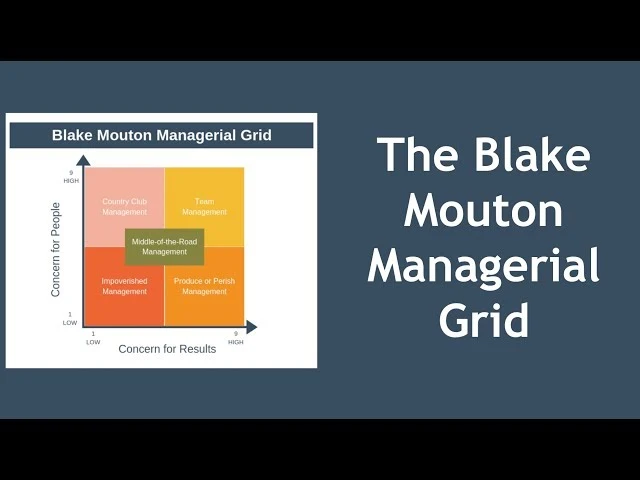
Blake & Mouton Managerial Grid Model
Effective leadership is a essential for organizational success, and understanding different leadership styles can help managers balance task accomplishment with team satisfaction. One widely recognized framework for evaluating leadership styles is the Managerial Grid Model. Developed by Robert R. Blake and Jane S. Mouton in the 1960s, this model provides insights into how managers prioritize task-oriented and people-oriented behaviors.
In this article, we will explore the Managerial Grid Model in detail, covering its structure, leadership styles, applications, advantages, and limitations, as well as the contribution of Blake and Mouton. By the end, you’ll understand how this model can enhance leadership effectiveness and organizational performance.
The Creators of the Managerial Grid Model: Robert R. Blake and Jane S. Mouton
The Managerial Grid Model was developed by Robert R. Blake and Jane S. Mouton, two American management theorists who revolutionized the study of leadership and organizational behavior.
About Robert R. Blake
- Background: Robert R. Blake was a prominent psychologist and management consultant with expertise in organizational development.
- Contributions: He focused on understanding human behavior in organizational settings and worked extensively on leadership theories.
About Jane S. Mouton
- Background: Jane S. Mouton was a management theorist and behavioral scientist. She collaborated with Blake on several research projects related to leadership and team dynamics.
- Contributions: Her expertise in interpersonal relationships and behavioral science complemented Blake's work on organizational psychology.
Blake and Mouton's Vision
- The duo introduced the Managerial Grid Model to bridge the gap between task-oriented and relationship-oriented leadership styles.
- Their research was aimed at helping managers strike a balance between achieving organizational goals and fostering employee satisfaction.
- The model was first introduced in their seminal book "The Managerial Grid: Leadership Styles for Achieving Production Through People", published in 1964.
Blake and Mouton’s work remains influential, shaping modern leadership development programs and management practices across industries.
What is the Managerial Grid Model?
The Managerial Grid Model, also known as the Leadership Grid, is a framework that assesses a manager's concern for production (task-oriented behavior) and concern for people (relationship-oriented behavior). It places these two dimensions on a grid to identify different leadership styles.
Key Dimensions of the Grid:
- Concern for Production (Task-Oriented Behavior):
- Represents the focus on achieving goals, meeting deadlines, and optimizing efficiency.
- Measured on a scale from 1 (low concern) to 9 (high concern).
- Concern for People (Relationship-Oriented Behavior):
- Represents the focus on employee welfare, satisfaction, and interpersonal relationships.
- Measured on a scale from 1 (low concern) to 9 (high concern).
Structure of the Managerial Grid
The Managerial Grid is a two-dimensional grid with the x-axis representing concern for production and the y-axis representing concern for people. The intersection of these two dimensions results in five primary leadership styles, each represented by a specific point on the grid.
The Five Leadership Styles:
1. Impoverished Leadership (1,1)
- Description: Low concern for both production and people.
- Characteristics:
- Minimal effort to get work done.
- Avoidance of responsibility.
- Lack of motivation and direction.
- Impact:
- Leads to low morale and productivity.
- Often results in a lack of clear goals and inefficient operations.
2. Task-Oriented Leadership (9,1)
- Description: High concern for production, low concern for people.
- Characteristics:
- Focuses solely on achieving results.
- Little regard for employee well-being.
- Emphasis on structure, processes, and strict deadlines.
- Impact:
- May achieve short-term goals but often leads to burnout and high turnover.
3. Country Club Leadership (1,9)
- Description: High concern for people, low concern for production.
- Characteristics:
- Prioritizes employee satisfaction and relationships.
- Avoids conflict and prioritizes harmony.
- Neglects performance and productivity.
- Impact:
- Creates a pleasant work environment but may result in inefficiency and missed objectives.
4. Middle-of-the-Road Leadership (5,5)
- Description: Moderate concern for both production and people.
- Characteristics:
- Balances task achievement and employee welfare.
- May compromise on excellence to maintain harmony.
- Impact:
- Achieves average performance but lacks innovation and high productivity.
5. Team-Oriented Leadership (9,9)
- Description: High concern for both production and people.
- Characteristics:
- Fosters collaboration and trust.
- Emphasizes achieving goals while maintaining employee satisfaction.
- Encourages innovation and teamwork.
- Impact:
- Leads to high performance, morale, and long-term success.
Applications of the Managerial Grid
The Managerial Grid Model is a valuable tool for understanding and improving leadership styles. Here’s how it can be applied in real-world scenarios:
1. Leadership Development
- Helps managers identify their dominant leadership style.
- Encourages leaders to strive for the 9,9 Team-Oriented Leadership style, which balances task accomplishment with employee satisfaction.
2. Team Building
- Assists in identifying potential conflicts between task-oriented and people-oriented team members.
- Promotes harmony by aligning leadership styles with team needs.
3. Performance Improvement
- Guides managers in adapting their leadership approach to improve team morale and productivity.
4. Organizational Culture
- Shapes a balanced organizational culture by encouraging leaders to prioritize both tasks and relationships.
5. Conflict Resolution
- Identifies leadership styles that may contribute to workplace conflicts, enabling managers to address issues effectively.
Conclusion
The Managerial Grid Model, created by Robert R. Blake and Jane S. Mouton, remains a cornerstone of leadership theory. By evaluating the balance between task-oriented and people-oriented behaviors, this framework helps managers identify areas for improvement and strive for the ideal Team-Oriented Leadership (9,9) style.
Blake and Mouton’s contributions have shaped how organizations develop leaders who drive productivity while fostering collaboration and employee satisfaction. Whether you’re a seasoned leader or an aspiring manager, the Managerial Grid offers timeless insights for navigating the complexities of leadership in modern workplaces.